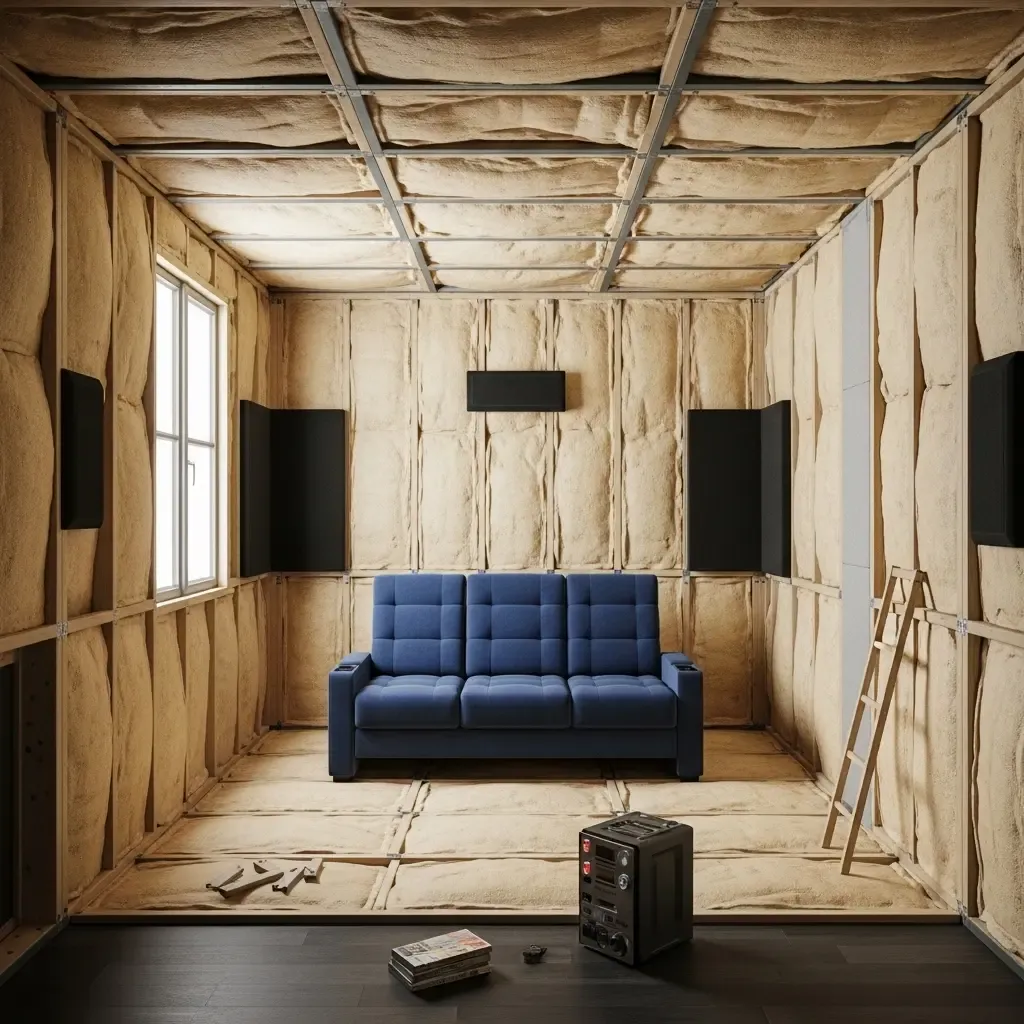How to Soundproof a Home Theater Room Effectively
 |
| How to Soundproof a Home Theater Room Effectively |
Today, we’re diving into the nitty-gritty of how to soundproof a home theater room without going broke. Whether you're trying to stop the neighbors from hearing your popcorn crunch or just want to get the most out of your surround sound, this guide has got you covered.
Start with the Basics: Understanding Soundproofing vs Acoustic Treatment
Before you dive in, it’s important to understand the difference between soundproofing and acoustic treatment. Soundproofing is all about stopping sound from escaping or coming in. Acoustic treatment, on the other hand, is about controlling how sound behaves inside the room—like reducing echoes or managing bass.
Want to enhance both? Be sure to check out our guide on how to design a home theater room with perfect acoustics.

Seal Every Gap and Crack
Let’s talk about the first step in any DIY home theater soundproofing project: sealing up every possible gap. Sound travels through the smallest cracks, so even a tiny hole in a wall can ruin your whole setup.
Use acoustic caulk or weatherstripping to seal around doors, windows, and any electrical outlets. Don’t forget the baseboards either—those are prime spots for sound to slip through. For affordable materials, check out Top 10 Affordable Soundproofing Products.
@obsessedhometheater Replying to @ΟΡΦΕΑΣ ΑΝΑΣΤΑΣΙΑΔΗΣ Stop echoes in your room #acoustics #acoustictreatment #acousticpanels #gik #theaterroom #4k #dolby #dolbyatmos #movies #music ♬ original sound - obsessedhometheater
Add Mass: The Power of Heavy Materials
When it comes to soundproofing, more mass equals better results. That’s why mass loaded vinyl is such a popular choice. It’s dense, flexible, and super effective at blocking sound. You can attach it directly to walls or floors, and it doesn’t take up much space.
If you’re on a budget, try using drywall with extra layers. You can even build a cinema space on a tight budget—just follow this media room budget guide.

Use Resilient Channels and Decoupling Techniques
If you really want to knock the sound down, consider using resilient channels or decoupling techniques. These methods involve separating the wall structure from the drywall, which helps prevent sound vibrations from traveling through the building.
Pair this with smart design strategies like those in our post on best seating arrangements for small home theaters to optimize both comfort and audio clarity.

Treat Your Windows and Doors
Windows and doors are two of the biggest culprits when it comes to sound leakage. If you’ve got standard glass windows, they’re probably letting in more noise than you realize. Consider replacing them with double-glazed or triple-glazed glass for better sound blocking.
Want stylish window treatments that don’t ruin your soundproofing efforts? Browse options from Curtarra or Affordable Blinds. As for doors, look for solid core options or enhance your current ones with door sweeps and weatherstripping.

Layer Up with Insulation
Insulation is one of the easiest ways to improve soundproofing in a small home theater room. Fiberglass, cellulose, or foam insulation can be installed in walls, ceilings, and floors to absorb sound and reduce transmission.
If you’re curious about products that balance eco-friendliness and performance, see what’s new at Ecovacs or Dreo—perfect for enhancing air flow and comfort while you insulate.

Control the Bass: Stop That Bounce
One of the biggest headaches in a home theater is bass bleed—that deep, rumbling sound that bounces around the room and messes up the audio experience. To fix this, focus on blocking low-frequency sound.
You can do this by adding bass traps in the corners of the room. Want your lighting to match your sound performance? Then don’t miss our list of the best lighting options for home theaters.

Use Green Glue and Other Soundproofing Adhesives
If you're doing a full build or renovation, Green Glue is a game-changer. It's a damping compound that goes between layers of drywall or flooring to absorb vibrations and reduce noise transfer.
For advanced tips, especially on wiring and audio-visual setups, don’t forget to read our breakdown on understanding HDMI cables.

Don’t Forget About the Floor
Sound doesn’t just travel through walls—it also goes through the floor. If your home theater is above another room, you’ll want to make sure the floor is properly soundproofed.
Use a floating floor system, underlayment, and soft finishes like rugs. Need a stylish upgrade? Browse interior solutions from Keetsa or explore cozy home additions at Thenestedfig.com.
Acoustic Treated Living Room Cinema
byu/Educational-Ad4934 inhometheater
byu/Educational-Ad4934 inhometheater
Test It Out Before You Commit
Once everything is in place, take the time to test your new soundproof home theater room. Play some loud music or a movie and see how it sounds from the outside. Are the neighbors still complaining? Is the sound getting muffled inside?
To make the most of your setup, follow our guide on how to calibrate your home theater audio system. You’d be surprised how much difference a few tweaks can make.
And there you have it, folks! Soundproofing a home theater room is no small task, but with the right materials and techniques, you can create a space that feels like a true cinematic experience. From DIY home theater soundproofing to mass loaded vinyl, there are plenty of options to suit any budget.
So grab that caulk, roll out that insulation, and start transforming your room today. Want to pair movie nights with sweet treats? Don’t miss the luxury offerings at ZChocolat or whimsical picks from Yaya and Co. Your future self—and your neighbors—will thank you. What’s stopping you now?








